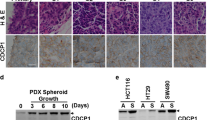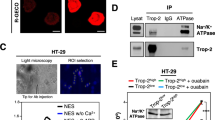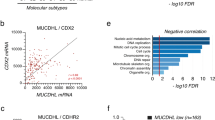Abstract
The neural L1 transmembrane cell adhesion receptor of the immunoglobulin-like family is a target gene of Wnt-β-catenin signaling in human colorectal cancer (CRC) cells and is expressed at the invasive edge of the tumor tissue. L1 overexpression in cultured CRC cells confers enhanced proliferation, motility and liver metastasis. We have analyzed the mechanisms of L1-mediated signaling in CRC cells by using various point mutations in the L1 ectodomain that are known to cause severe genetically inherited mental retardation disorders in patients. We found that all such L1 ectodomain mutations abolish the ability of L1 to confer metastatic properties in CRC cells. Using gene array analysis, we identified L1-mutation-specific gene expression signatures for the L1/H210Q and L1/D598N mutations. We identified CD10, a metalloprotease (neprilysin, neutral endopeptidase) and a gene that is specifically induced in CRC cells by L1 in an L1/H210Q mutation-specific manner. CD10 expression was required for the L1-mediated induction of cell proliferation, motility and metastasis, as suppression of CD10 levels in L1-expressing CRC cells abolished the L1 effects on CRC progression. The signaling from L1 to CD10 was mediated through the L1-ezrin-NF-κB pathway. In human CRC tissue L1 and CD10 were localized in partially overlapping regions in the more invasive areas of the tumor tissue. The results suggest that CD10 is a necessary component conferring the L1 effects in CRC cells. The identification of gene expression patterns of L1-domain-specific point mutations may provide novel markers and targets for interfering with L1-mediated CRC progression.
This is a preview of subscription content, access via your institution
Access options
Subscribe to this journal
Receive 50 print issues and online access
$259.00 per year
only $5.18 per issue
Buy this article
- Purchase on Springer Link
- Instant access to full article PDF
Prices may be subject to local taxes which are calculated during checkout







Similar content being viewed by others
References
Grumet M . Cell adhesion molecules and their subgroups in the nervous system. Curr Opin Neurobiol 1991; 1: 370–376.
Chang S, Rathjen FG, Raper JA . Extension of neurites on axons is impaired by antibodies against specific neural cell surface glycoproteins. J Cell Biol 1987; 104: 355–362.
Rathjen FG, Wolff JM, Frank R, Bonhoeffer F, Rutishauser U . Membrane glycoproteins involved in neurite fasciculation. J Cell Biol 1987; 104: 343–353.
Lemmon V, Farr KL, Lagenaur C . L1-mediated axon outgrowth occurs via a homophilic binding mechanism. Neuron 1989; 2: 1597–1603.
Friedlander DR, Milev P, Karthikeyan L, Margolis RK, Margolis RU, Grumet M . The neuronal chondroitin sulfate proteoglycan neurocan binds to the neural cell adhesion molecules Ng-CAM/L1/NILE and N-CAM, and inhibits neuronal adhesion and neurite outgrowth. J Cell Biol 1994; 125: 669–680.
Cohen NR, Taylor JS, Scott LB, Guillery RW, Soriano P, Furley AJ . Errors in corticospinal axon guidance in mice lacking the neural cell adhesion molecule L1. Curr Biol 1998; 8: 26–33.
Jouet M, Rosenthal A, Armstrong G, MacFarlane J, Stevenson R, Paterson J et al. X-linked spastic paraplegia (SPG1), MASA syndrome and X-linked hydrocephalus result from mutations in the L1 gene. Nat Genet 1994; 7: 402–407.
Wong EV, Kenwrick S, Willems P, Lemmon V . Mutations in the cell adhesion molecule L1 cause mental retardation. Trends Neurosci 1995; 18: 168–172.
Kamiguchi H, Hlavin ML, Lemmon V . Role of L1 in neural development: what the knockouts tell us. Mol Cell Neurosci 1998; 12: 48–55.
Conacci-Sorrell ME, Ben-Yedidia T, Shtutman M, Feinstein E, Einat P, Ben-Ze'ev A . Nr-CAM is a target gene of the beta-catenin/LEF-1 pathway in melanoma and colon cancer and its expression enhances motility and confers tumorigenesis. Genes Dev 2002; 16: 2058–2072.
Gavert N, Conacci-Sorrell M, Gast D, Schneider A, Altevogt P, Brabletz T et al. L1, a novel target of beta-catenin signaling, transforms cells and is expressed at the invasive front of colon cancers. J Cell Biol 2005; 168: 633–642.
Gavert N, Sheffer M, Raveh S, Spaderna S, Shtutman M, Brabletz T et al. Expression of L1-CAM and ADAM10 in human colon cancer cells induces metastasis. Cancer Res 2007; 67: 7703–7712.
Gavert N, Ben-Shmuel A, Lemmon V, Brabletz T, Ben-Ze'ev A . Nuclear factor-kappaB signaling and ezrin are essential for L1-mediated metastasis of colon cancer cells. J Cell Sci 2010; 123: 2135–2143.
De Angelis E, MacFarlane J, Du JS, Yeo G, Hicks R, Rathjen FG et al. Pathological missense mutations of neural cell adhesion molecule L1 affect homophilic and heterophilic binding activities. EMBO J 1999; 18: 4744–4753.
De Angelis E, Watkins A, Schafer M, Brummendorf T, Kenwrick S . Disease-associated mutations in L1 CAM interfere with ligand interactions and cell-surface expression. Hum Mol Genet 2002; 11: 1–12.
Beer S, Oleszewski M, Gutwein P, Geiger C, Altevogt P . Metalloproteinase-mediated release of the ectodomain of L1 adhesion molecule. J Cell Sci 1999; 112 (Pt 16): 2667–2675.
Felding-Habermann B, Silletti S, Mei F, Siu CH, Yip PM, Brooks PC et al. A single immunoglobulin-like domain of the human neural cell adhesion molecule L1 supports adhesion by multiple vascular and platelet integrins. J Cell Biol 1997; 139: 1567–1581.
Oleszewski M, Beer S, Katich S, Geiger C, Zeller Y, Rauch U et al. Integrin and neurocan binding to L1 involves distinct Ig domains. J Biol Chem 1999; 274: 24602–24610.
Shapiro B, Tocci P, Haase G, Gavert N, Ben-Ze'ev A . Clusterin, a gene enriched in intestinal stem cells, is required for L1-mediated colon cancer metastasis. Oncotarget 2015; 6: 34389–34401.
Yao T, Takata M, Tustsumi S, Nishiyama K, Taguchi K, Nagai E et al. Phenotypic expression of gastrointestinal differentiation markers in colorectal adenocarcinomas with liver metastasis. Pathology 2002; 34: 556–560.
Ohji Y, Yao T, Eguchi T, Yamada T, Hirahashi M, Iida M et al. Evaluation of risk of liver metastasis in colorectal adenocarcinoma based on the combination of risk factors including CD10 expression: multivariate analysis of clinicopathological and immunohistochemical factors. Oncol Rep 2007; 17: 525–530.
Koga Y, Yao T, Hirahashi M, Kumashiro Y, Ohji Y, Yamada T et al. Flat adenoma-carcinoma sequence with high-malignancy potential as demonstrated by CD10 and beta-catenin expression: a different pathway from the polypoid adenoma-carcinoma sequence. Histopathology 2008; 52: 569–577.
Maguer-Satta V, Besancon R, Bachelard-Cascales E . Concise review: neutral endopeptidase (CD10): a multifaceted environment actor in stem cells, physiological mechanisms, and cancer. Stem Cells 2011; 29: 389–396.
Ben-Shmuel A, Shvab A, Gavert N, Brabletz T, Ben-Ze'ev A . Global analysis of L1-transcriptomes identified IGFBP-2 as a target of ezrin and NF-kappaB signaling that promotes colon cancer progression. Oncogene 2013; 32: 3220–3230.
Malfroy B, Kuang WJ, Seeburg PH, Mason AJ, Schofield PR . Molecular cloning and amino acid sequence of human enkephalinase (neutral endopeptidase). FEBS Lett 1988; 229: 206–210.
Erdos EG, Skidgel RA . Neutral endopeptidase 24.11 (enkephalinase) and related regulators of peptide hormones. FASEB J 1989; 3: 145–151.
Ogawa H, Iwaya K, Izumi M, Kuroda M, Serizawa H, Koyanagi Y et al. Expression of CD10 by stromal cells during colorectal tumor development. Hum Pathol 2002; 33: 806–811.
Haspel J, Grumet M . The L1CAM extracellular region: a multi-domain protein with modular and cooperative binding modes. Front Biosci 2003; 8: s1210–s1225.
Silletti S, Yebra M, Perez B, Cirulli V, McMahon M, Montgomery AM . Extracellular signal-regulated kinase (ERK)-dependent gene expression contributes to L1 cell adhesion molecule-dependent motility and invasion. J Biol Chem 2004; 279: 28880–28888.
Schmid RS, Maness PF . L1 and NCAM adhesion molecules as signaling coreceptors in neuronal migration and process outgrowth. Curr Opin Neurobiol 2008; 18: 245–250.
Gavert N, Shvab A, Sheffer M, Ben-Shmuel A, Haase G, Bakos E et al. c-Kit is suppressed in human colon cancer tissue and contributes to L1-mediated metastasis. Cancer Res 2013; 73: 5754–5763.
Hlavin ML, Lemmon V . Molecular structure and functional testing of human L1CAM: an interspecies comparison. Genomics 1991; 11: 416–423.
Brabletz T, Jung A, Dag S, Hlubek F, Kirchner T . beta-catenin regulates the expression of the matrix metalloproteinase-7 in human colorectal cancer. Am J Pathol 1999; 155: 1033–1038.
Acknowledgements
We thank Drs N Iwata, M Shtutman, F Rathjen and V Lemmon for providing reagents. This study was supported by grants from the Israel Science Foundation (ISF) and from the Israel Cancer Research Fund (ICRF). A B-Z is the incumbent of the Lunenfeld-Kunin professorial chair in genetics and cell biology.
Author information
Authors and Affiliations
Corresponding author
Ethics declarations
Competing interests
The authors declare no conflict of interest.
Additional information
Supplementary Information accompanies this paper on the Oncogene website
Supplementary information
Rights and permissions
About this article
Cite this article
Haase, G., Gavert, N., Brabletz, T. et al. A point mutation in the extracellular domain of L1 blocks its capacity to confer metastasis in colon cancer cells via CD10. Oncogene 36, 1597–1606 (2017). https://doi.org/10.1038/onc.2016.329
Received:
Revised:
Accepted:
Published:
Issue Date:
DOI: https://doi.org/10.1038/onc.2016.329



